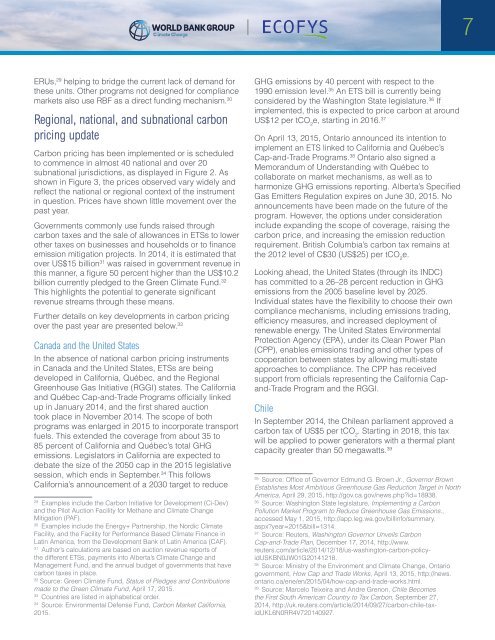OxibL
OxibL
OxibL
- No tags were found...
Create successful ePaper yourself
Turn your PDF publications into a flip-book with our unique Google optimized e-Paper software.
7ERUs, 29 helping to bridge the current lack of demand forthese units. Other programs not designed for compliancemarkets also use RBF as a direct funding mechanism. 30Regional, national, and subnational carbonpricing updateCarbon pricing has been implemented or is scheduledto commence in almost 40 national and over 20subnational jurisdictions, as displayed in Figure 2. Asshown in Figure 3, the prices observed vary widely andreflect the national or regional context of the instrumentin question. Prices have shown little movement over thepast year.Governments commonly use funds raised throughcarbon taxes and the sale of allowances in ETSs to lowerother taxes on businesses and households or to financeemission mitigation projects. In 2014, it is estimated thatover US$15 billion 31 was raised in government revenue inthis manner, a figure 50 percent higher than the US$10.2billion currently pledged to the Green Climate Fund. 32This highlights the potential to generate significantrevenue streams through these means.Further details on key developments in carbon pricingover the past year are presented below. 33Canada and the United StatesIn the absence of national carbon pricing instrumentsin Canada and the United States, ETSs are beingdeveloped in California, Québec, and the RegionalGreenhouse Gas Initiative (RGGI) states. The Californiaand Québec Cap-and-Trade Programs officially linkedup in January 2014, and the first shared auctiontook place in November 2014. The scope of bothprograms was enlarged in 2015 to incorporate transportfuels. This extended the coverage from about 35 to85 percent of California and Québec’s total GHGemissions. Legislators in California are expected todebate the size of the 2050 cap in the 2015 legislativesession, which ends in September. 34 This followsCalifornia’s announcement of a 2030 target to reduce29Examples include the Carbon Initiative for Development (Ci-Dev)and the Pilot Auction Facility for Methane and Climate ChangeMitigation (PAF).30Examples include the Energy+ Partnership, the Nordic ClimateFacility, and the Facility for Performance Based Climate Finance inLatin America, from the Development Bank of Latin America (CAF).31Author’s calculations are based on auction revenue reports ofthe different ETSs, payments into Alberta’s Climate Change andManagement Fund, and the annual budget of governments that havecarbon taxes in place.32Source: Green Climate Fund, Status of Pledges and Contributionsmade to the Green Climate Fund, April 17, 2015.33Countries are listed in alphabetical order.34Source: Environmental Defense Fund, Carbon Market California,2015.GHG emissions by 40 percent with respect to the1990 emission level. 35 An ETS bill is currently beingconsidered by the Washington State legislature. 36 Ifimplemented, this is expected to price carbon at aroundUS$12 per tCO 2e, starting in 2016. 37On April 13, 2015, Ontario announced its intention toimplement an ETS linked to California and Québec’sCap-and-Trade Programs. 38 Ontario also signed aMemorandum of Understanding with Québec tocollaborate on market mechanisms, as well as toharmonize GHG emissions reporting. Alberta’s SpecifiedGas Emitters Regulation expires on June 30, 2015. Noannouncements have been made on the future of theprogram. However, the options under considerationinclude expanding the scope of coverage, raising thecarbon price, and increasing the emission reductionrequirement. British Columbia’s carbon tax remains atthe 2012 level of C$30 (US$25) per tCO 2e.Looking ahead, the United States (through its INDC)has committed to a 26–28 percent reduction in GHGemissions from the 2005 baseline level by 2025.Individual states have the flexibility to choose their owncompliance mechanisms, including emissions trading,efficiency measures, and increased deployment ofrenewable energy. The United States EnvironmentalProtection Agency (EPA), under its Clean Power Plan(CPP), enables emissions trading and other types ofcooperation between states by allowing multi-stateapproaches to compliance. The CPP has receivedsupport from officials representing the California Capand-TradeProgram and the RGGI.ChileIn September 2014, the Chilean parliament approved acarbon tax of US$5 per tCO 2. Starting in 2018, this taxwill be applied to power generators with a thermal plantcapacity greater than 50 megawatts. 3935Source: Office of Governor Edmund G. Brown Jr., Governor BrownEstablishes Most Ambitious Greenhouse Gas Reduction Target in NorthAmerica, April 29, 2015, http://gov.ca.gov/news.php?id=18938.36Source: Washington State legislature, Implementing a CarbonPollution Market Program to Reduce Greenhouse Gas Emissions.,accessed May 1, 2015, http://app.leg.wa.gov/billinfo/summary.aspx?year=2015&bill=1314.37Source: Reuters, Washington Governor Unveils CarbonCap-and-Trade Plan, December 17, 2014, http://www.reuters.com/article/2014/12/18/us-washington-carbon-policyidUSKBN0JW01G20141218.38Source: Ministry of the Environment and Climate Change, Ontariogovernment, How Cap and Trade Works, April 13, 2015, http://news.ontario.ca/ene/en/2015/04/how-cap-and-trade-works.html.39Source: Marcelo Teixeira and Andre Grenon, Chile Becomesthe First South American Country to Tax Carbon, September 27,2014, http://uk.reuters.com/article/2014/09/27/carbon-chile-taxidUKL6N0RR4V720140927.



